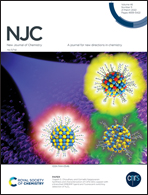Synthesis and characterization of CdTe QDs capped with a branched 3MB3MP ligand and fluorescent switching detection of H2O2†
Abstract
Due to the possibility of modification with various multifunctional ligand groups, and thereby attaining selective and sensitive detection, water soluble quantum dots (QDs) continue to attract scientific attention, in the realm of fluorescence based sensing. Herein, we describe the synthesis of highly fluorescent water soluble CdTe QDs using a novel branched ligand 3-methoxybutyl 3-mercaptopropionate (3MB3MP), using a facile colloidal synthesis method. The synthesized QDs show excitation independent high fluorescence emission at a wavelength of 590 nm with excellent temporal stability and an atypical phenomenon of photo-enhancement effect. A novel label free fluorescence based detection of H2O2 has also been demonstrated using CdTe@3MB3MP QDs. The fluorescence emission of the CdTe@3MB3MP QDs was found to be enhanced in a linear fashion in the presence of H2O2, within a linear concentration range of 10–250 nM, which was then found to plummet significantly at concentrations higher than 300 nM. Thorough photophysical and microscopic characterizations have been carried out in order to unveil the mechanism of photo-enhancement as well as H2O2 detection.



 Please wait while we load your content...
Please wait while we load your content...